Oil Recycling technologies and ways of realization
Oil recycling is an important direction in handling mankind’s industrial waste. To make the existing ecological situation better, it is vitally important to organize a proper waste oil collection and delivery to specialized enterprises engaged in oil recycling.
Oil recycling is not exactly a new problem. Recent years have seen significant progress in recycling technologies which can restore 70-85% of used oil to as good as new condition, and in some cases as much as 90% of the material. The resulting product can be recycled again and again, several times. The importance of oil recycling is easy to see even by simply comparing the numbers: product output from crude oil processing rarely exceeds 10%. This makes oil recycling quite interesting as an idea for starting a business.
The potential profit increases even more, if 35-54% of waste oil can be collected. In this case, the energy costs of purifying and recycling the oil is almost 20 times less than those required to produce the same amount of material from crude oil.
HISTORY
The global amount of waste oil is estimated at 40 million tons a year. Less than half of that amount is collected, while only approximately 2 million tons are recycled, i.e., 5% of the total amount.
In Europe, 30 to 40% of waste oil, on average, is processed into high quality products. The breakthrough was started by the 75/439/ЕЕС Directive, which was adopted in the EU in 1975. The document regulates creation of an integral system of collection, transportation, storage and processing the oil without causing harm to the environment. The Directive drastically changed the outlook of oil recycling. After its adoption, used oil became a valuable raw material for reuse, not a waste to be disposed of. The leading technology in Europe is oil regeneration, viable both economically and environmentally. Each of the EU members reports to a special commission three times per year on recycling and reprocessing oil in their respective nations.
Great Britain leads the way, with a strong government program. It is this program that makes it possible to recycle up to 86% of all waste oil products. Over a thousand small oil regeneration units are located in the United Kingdom. They are most often situated in waste recycling facilities. Germany, Italy, Belgium, the Netherlands and Luxembourg have also achieved significant progress in the matter.
WHAT DOES THE STATISTICS SAY?
Statistical data on waste oil generation and consumption in various countries is collected in the table below.
Table 1
GENERATION AND CONSUMPTION OF WASTE OIL IN VARIOUS COUNTRIES, THOUSAND TONS A YEAR
| Country | Oil consumption | Waste oil collection | Waste oil recycling |
| Russia and ex-USSR countries | 7800 | 1700 | 260 |
| USA | 10000 | 4000 | approx. 400 |
| Canada | 1400 | – | approx.250 |
| Germany | 1460 | 730 | 400 |
| United Kingdom | 800 | 200 | 150 |
| France | 850 | 250 | 200 |
| Italy | 630 | 200 | 150 |
| The Netherlands | 500 | 200 | 15 |
As shown by the data, developed countries recycle 30-38% of waste mineral oil. Such careful use of resources is partly due to the fact that these countries have no crude oil production of their own and must import oil from abroad.
What about waste oil?
Waste oil is mineral or synthetic oil that was in operation and is severely contaminated. Waste oils that can be managed are:
- gear oils;
- engine oils;
- brake fluids;
- hydraulic fluids;
- turbine oils;
- compressor oils;
- cable oils;
- transformer oils;
- grease;
- heat transfer medium.
RECYCLING OF WASTE LUBE OIL
Waste lube oil is a liquid waste product, any oil, produced from crude oil, or synthetic oils, contaminated by physical or chemical impurities. Even normal use of oil does not prevent contamination of oil with dirt, metal particles, water or various chemicals. With time, the amount of impurities exceeds a certain threshold and the material can no longer be used for its original purpose.
Environmentally safe recycling of lube oil results in the production of various commercial products (plastic lubricants, fuels, oils, anti-rust grease etc).
Waste that is not considered as waste oil:
- sludge after cleaning oil tanks;
- waste that partly includes waste oil;
- various solvents, fuel kerosene, automobile antifreeze;
- waste, which cannot be processed like oil.
Danger from waste oil is even greater than from crude oil. It is due to waste oil composition containing resins, carbenes, asphaltenes and other substances that adversely affect human health. Waste oil spills severely pollute water bodies and soil, also having a carcinogenic effect.
TRANSFORMER OIL CHARACTERISTICS AND USE
Transformer oil is indispensable in oil-immersed switches and transformers. Large amounts of such devices exist in any country, making careful maintenance a preferred method of extending the longevity of the equipment. Preventive maintenance is a lot less costly than purchasing a new transformer. One of the most important tasks is to restore the quality of transformer oil for reuse.
During use, the oil’s acid number increases, causing the following in transformers:
- Increased activity of corrosive sulfur. This results in oxidation of contacts and transformer efficiency deteriorates;
- The content of metal soaps increase, the dielectric strength decreases;
- Sulfur compounds, which can damage the metal parts of the transformer, form in the oil.
These factors reduce the potential use of the insulation fluid.
The main quality requirements to transformer oil are:
- High dielectric strength;
- Low viscosity variations due to ambient temperature changes.
TRANSFORMER OIL PURIFICATION
Purification of transformer oil is an important component of transformer maintenance. The need to purify the oil is due to the accumulation of impurities: solid particles, water, gases etc. These form the so called conductivity bridges, which may cause a short circuit. With time, water and gas appear in the oil. They decrease the dielectric strength of the oil. High voltage transformers (above 60 kV) are especially vulnerable.
Beside purification, there is the regeneration technology which restores the oil’s quality completely. With correct schedule of regeneration, a transformer can last more than 20 years longer.
Used oil quality requirements are listed in table 2.
Table 2
USED OIL QUALITY REQUIREMENTS FOR RECYCLING
| Parameter | Normal values for used oil | ||
| Used oils | Used industrial oils | Spent oil mix | |
| Kinetic viscosity at 50 ⁰С, mm2/sec | >35 | 5-35 | – |
| Relative viscosity at 20⁰С, mm2/sec | >40 | 13-40 | – |
| Flashpoint, ⁰С | ≤100 | ≤120 | – |
| Content by weight,. % Solid particles
Water |
≤1≤2 | ≤1≤2 | ≤1
≤2 |
Among the many types of oil recycling machines, the CMM-R units merit special attention:
- Complete restoration of used transformer oil for reuse;
- Reactivation of saturated sorbent directly in the unit;
- The capability to process oil in transformer under load, reducing financial costs due to transformer down time.
TRANSFORMER OIL RECYCLING: GENERAL OVERVIEW OF CURRENT APPROACHES
All regeneration methods aim to improve quality and chemical purity of transformer oil. With this in mind, the process must include:
- Oil drying;
- Oil degassing;
- Restoration of dielectric strength;
- Reduction of acidity.
Transformer oil treatment is usually a multi-stage process, with both physical and chemical methods employed. Mechanical treatment is a good initial step to get rid of more than 70% of impurities. Chemical treatment, 95 to 98% efficient, is required for a more thorough recycling.
CONTROLLING QUALITY OF REGENERATED TRANSFORMER OIL
Several tests are performed after regeneration of oil to assess its usability as a dielectric and compliance with standards:
- Density at 20ºС;
- Viscosity;
- Flashpoint;
- Cloud point;
- Dielectric strength;
- Oxidation stability.
The complex testing also includes dissolved gas analysis, interfacial tension measurement and saturated vapor pressure. All these indications allow to determine if the regeneration was successful.
Oil recycling: basic technologies
Understanding the necessity of oil processing has come a long time ago. But the first serious steps in this direction were made only four decades ago. Waste oil was burned to receive energy for heating. In the modern understanding, oil recycling is a preliminary cleaning and subsequent production of commercial fuels and oils, or reuse in the same equipment.
Burning of waste oil without preliminary processing is dangerous and releases a large amount of harmful substances into the atmosphere. Therefore, the oil must be cleaned before burning. This process is controlled by local authorities.
Power industry outlines oil processing on site with full restoration of oil properties as the priority direction. To restore the important performance properties of petroleum products are used mobile regeneration plants from GlobeCore.
Oil recycling machine
Recycling oil is a procedure that is designed for restoring used oil condition. Oil recycling machine is a utility that can easily and successfully cope with this task. Due to the fact, that manufacturing process is very expensive, this method is optimal for cost saving.
Oil recycling is a perfect option for industrial and other purposes, but it’s important to remember main points about resources, that have already been operated.
Of course this solution is good and quite widespread, but bare uncleared used oil MUSTN’T BE INVOLVED in any processing.
There are a number of significant facts that should be noticed.
Used oil
Used oil can be good alternative to buying new one. But before launching it you have to take into account the main issues:
- Used oils are hazardous for natural environment;
- Unpurified oil in a bad condition is harmful for any machinery systems;
- There are certain established norms in worldwide industry that mustn’t be neglected.
If you have intention to operate with used oil, you should produce oil recycling.
Consequences of using untreated oil
Aging or deterioration of oil in the transformer, especially insulating, leads first to oxidation that attacks cellulose and metals.This process creates soap metal, aldehyde and other different heavy substances on the insulation, side walls of the tank, in respiratory, cooling and other systems.
The mud that appears increases the viscosity of the oil, and as a result transformer reduces its cooling capacity and lifetime .
All this factors influence on efficiency and causes further damages.
General rules for waste oil management are as follows:
- determining which substance belongs to “waste oils”;
- collecting and marking the containers;
- storing and protecting from the influence of harmful factors;
- oil processing with GlobeCore equipment.
GlobeCore units can process oil without draining it from equipment. For example, CMM-R unit connects directly to a transformer, and the oil recovery goes in a closed loop between transformer and oil regeneration unit. This avoids the collection phase, saves time and money
Oil recycling plants
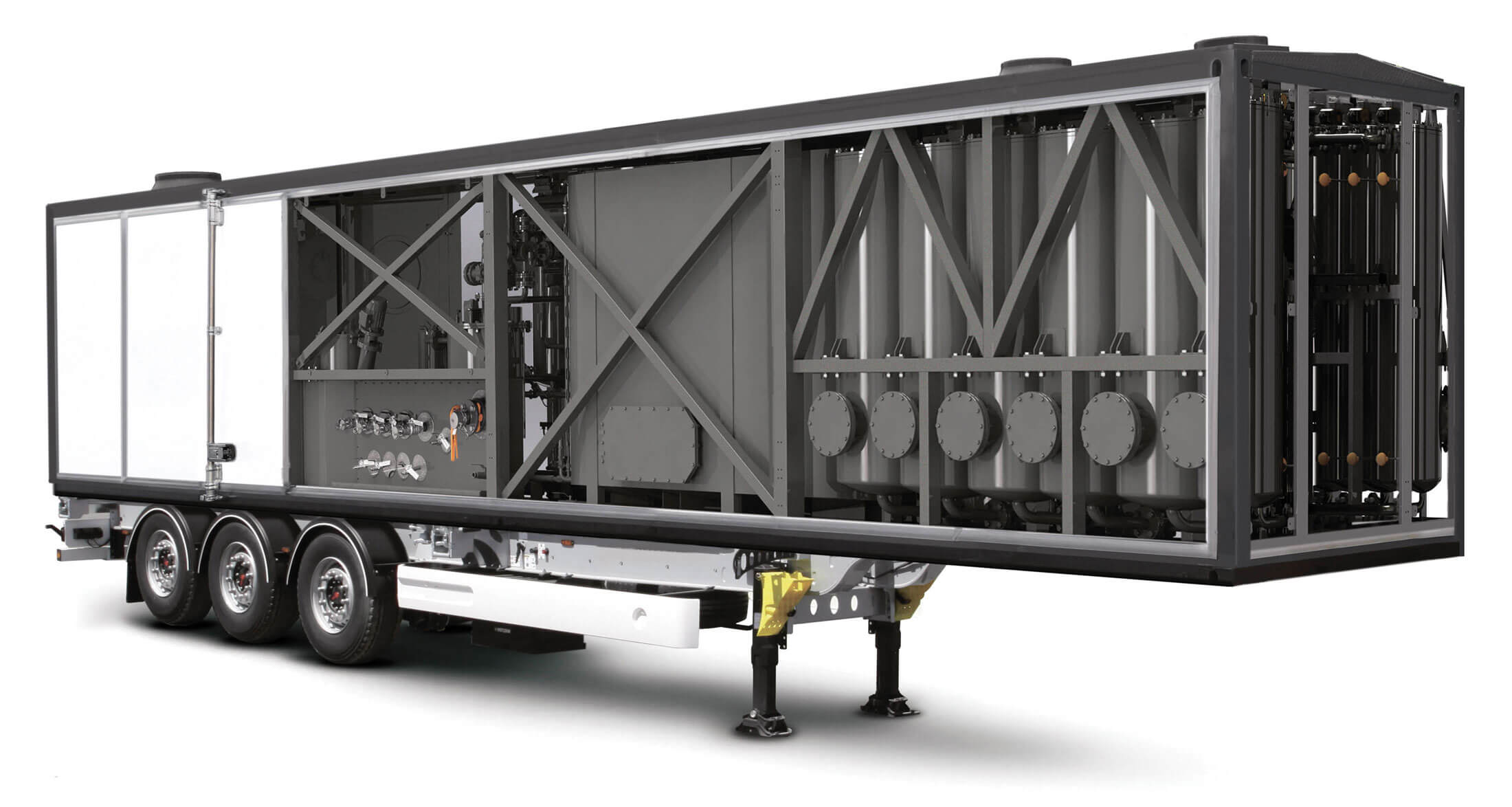
There is a unique oil recycling system, designed by GlobeCore.
Regeneration of the oil in a transformer restores used oil to new like condition:
| Parameter | Before processing | After processing |
| Moisture content by weight,g/t (ppm) as per
IEC 733; ASTM D-1533 |
43 | 5 |
| ISO 4406 industrial purity class | -/18/16 | -/14/12 |
| Volumetric gas content % I.A.W.IEC 60599; ASTM D-3612 | – | 0.1 |
| Acid number, mg KOH/g I.A.W IEC 296; ASTM D-664 | 0.2 | 0.01 |
| Corrosive sulfur I.A.W.*IEC 5662; ASTM D-1275 | present | absent |
| Dielectric strength, kV I.A.W. IEC 156; ASTM D-18116 | 30 | 70 |
| Interfacial tension, N/m, at 25ºС I.A.W. IEC 6295; ASTM D-664 | 45 | |
| Dissipation factor at 90ºС I.A.W.IEC 247; ASTM D-924 | 0.095 | 0.001 |
| Oxidation stability I.A.W. IEC 74; 164 hours | restored |
(*I.A.W. In Accordance With)
CMM-R is a oil recycling machine that is optional for transformer manufacturers and for transformer service.
It will not only restore the content condition, but also approve final disposal agent.
- CMM-R oil recycling machine uses a sorbent, that removes all oxidation, pollution and other types of contaminants .
Recycling system can be used in combination with degassing or drying units.
CMM-R can be used for oil recycling, oil degradation or oil cleaning.
This oil recycling mashine has its own unique features as a function of transformer vacuuming and ability to be controlled and monitored via smartphone or PC.
- The other modification of oil recycling equipment is UVR TRANSFORMER OIL REGENERATION UNIT
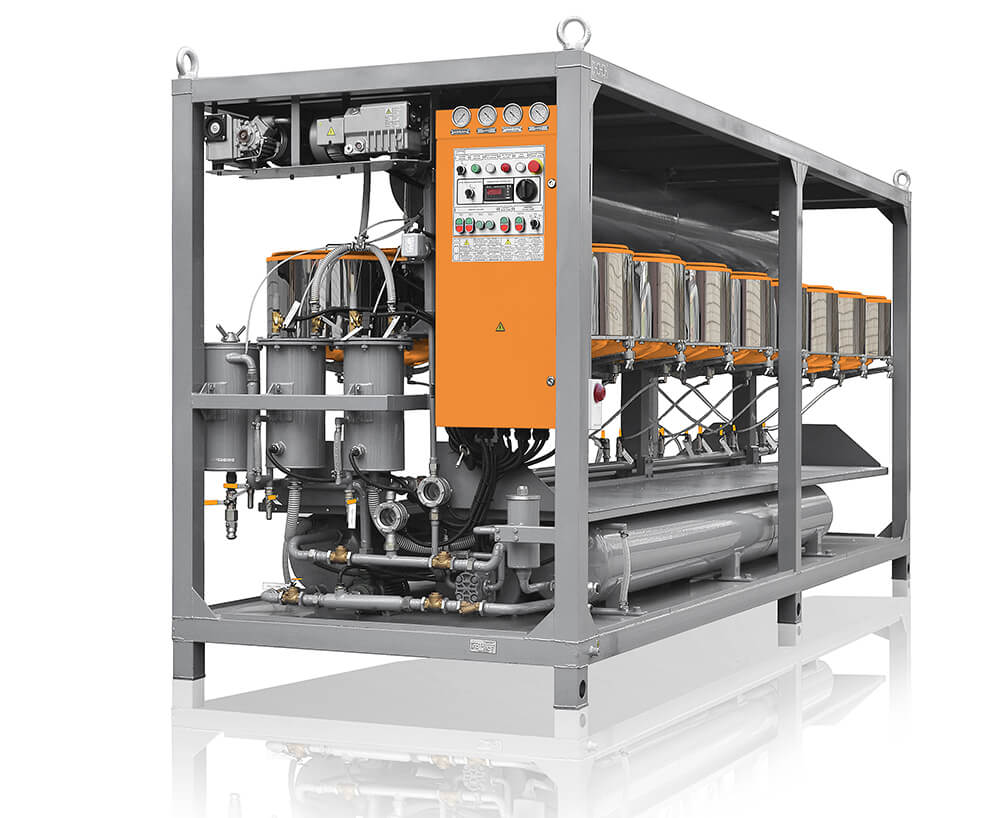
It is designed for the recycling and purification of fuels and used mineral oils. The UVR Regeneration Units utilize “Bleaching Clay” instead of Fuller’s Earth.
| Parameter | Value | |||
| Regeneration capacity, m3/hour/gals. per hour: | UVR-450/6 | UVR-450/16 | UVR-450/16/k | UVR-450/16/v |
| • transformer oil | 0.08-0.1/21.2 | 0.20-0.27/53.0-71.5 | 0.20-0.27/53.0-71.5 | 0.20-0.27/53.0-71.5 |
| • turbine oil | 0.08-0.1/26.5 | 0.20-0.27/ 53.0-71.5 | 0.20-0.27/ 53.0-71.5 | 0.20-0.27/53.0-71.5 |
| • industrial oil | 0.08-0.1/26.5 | 0.15-0.20/39.2-53.0 | 0.15-0.20/39.2-53.0 | – |
| • dark fuel oil | 0.25/66.2 | 0.6-0.8/159-213 | 0.6-0.8/159-213 | 0.6-0.8/159-213 |
| • dark diesel fuel | 0.25/66.2 | 0.6-0.8/159/213 | 0.6-0.8/159/213 | 0.6-0.8/159/213 |
| • dark gas condensate | 0.30/19.4 | 0.7-1.1185/291 | 0.7-1.1185/291 | 0.7-1.1185/291 |
| Consumption of regeneration powder as % of processed product weight
• transformer oil • turbine oil |
3-17
3-17 |
3-17
3-17 |
3-17
3-17 |
3-17
3-17 |
| • industrial oil | 3-17 | 3-17 | 3-17 | – |
| • dark fuel oil
• dark diesel fuel • dark gas condensate |
2-15
1-7 1-5 |
2-15
1-7 1-5 |
2-15
1-7 1-5 |
2-15
1-7 1-5 |
| Regeneration poweder load | 20 /44.2 | 20 /44.2 | 20 /44.2 | 20 /44.2 |
| • one regeneration pod, kg/lbs | ||||
| • all regeneration pods, kg/lbs | 120/265.2 | 320/707.2 | 320/707.2 | 320/707.2 |
| Loss (of oil product) % of initial volume (remains in the sorbent)
• transformer oil • turbine oil |
1-6
1-6 |
1-6
1-6 |
1-6
1-6 |
1-6
1-6 |
| • industrial oil | 1-6 | 1-6 | 1-6 | 1-6 |
| • dark fuel oil
• dark diesel fuel • dark gas condensate |
1-6
1-6 1-6 |
1-6
1-6 1-6 |
1-6
1-6 1-6 |
1-6
1-6 1-6 |
| Total power of heaters, kW | 1.98 | 5.28 | 5.28 | – |
| Nominal power, kW | 5 | 8 | 13 | 8 |
| Power consumption with heating off, kWh | 3 | 2.72 | 7.7 | 5 |
| Filtration fineness, in microns | 500 | 500 | 500 | 500 |
| • inlet | ||||
| • outlet | 5 (3) | 5 (3) | 5 (3) | 5 (3) |
| Three phase 50(60) Hz power voltage, V | 380 | 380 | 380 | 380 |
| Dimensions, mm/ft, length/ width/ height | 1 section | 1 section | container | 1 section |
| 2600/1500/2030 | 4800/1500/2140 | 6060/2590/2440 | 4800/1500/2140 | |
| 8’6”/4’11”/6’8” | 15’9”/4’11”/7’ | 19’11”/8’6”/8’ | 15’9”/4’11”/7’ | |
| Weight, kg/lbs | 1100/2,431 | 2350/5,193.5 | 7000/15,470 | 3400/7,514 |
Unit can either purify and clear up dark diesel fuel and heavy fuel oil. Treated oil get’s quality as if it is new.
Brilliant results and reviews of satisfied customers is a pride of GlobeCore and goal that companies’ developers have achieved by zealous work, whose main idea is improvement of industrial technologies.


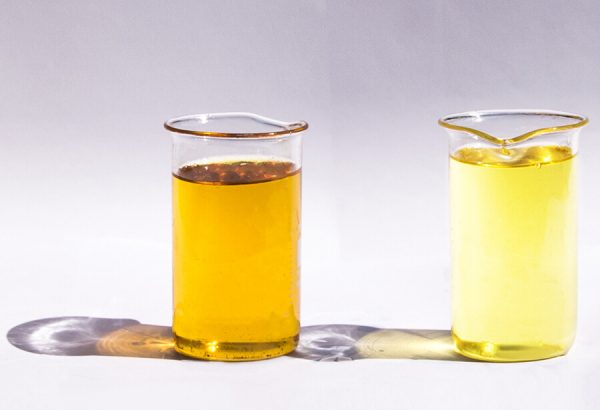
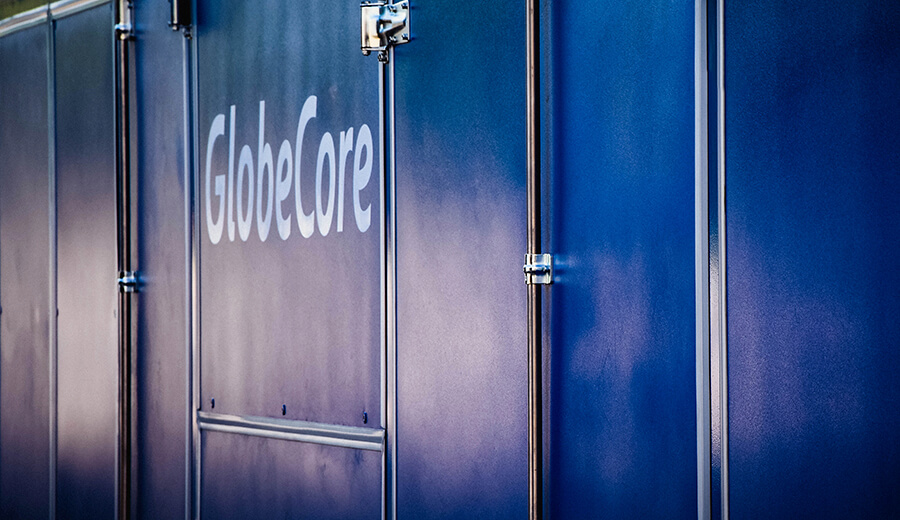
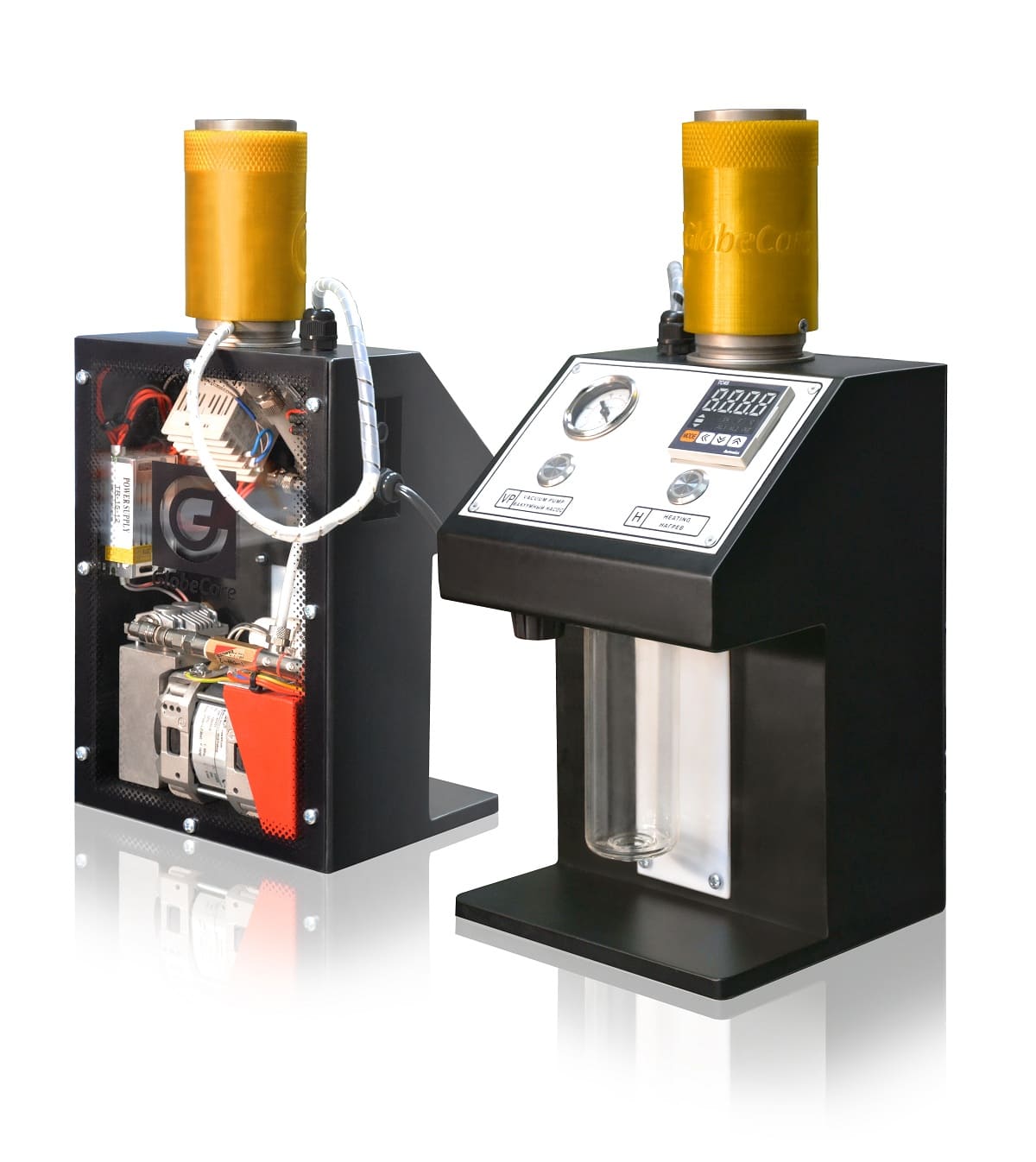 СММ-0,001U Laboratory Oil ...
СММ-0,001U Laboratory Oil ...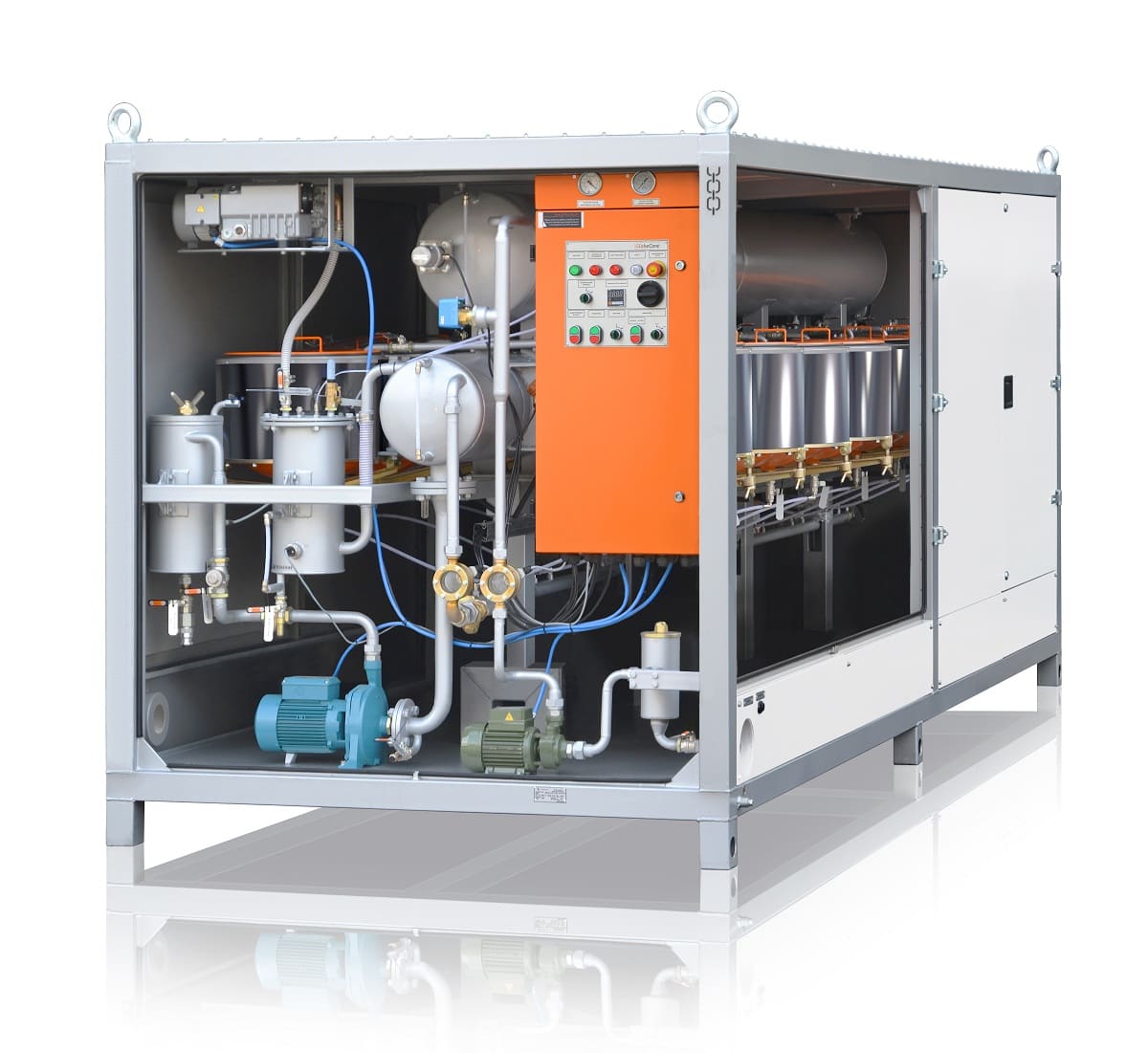 Private: CMM-450/16U Transformer ...
Private: CMM-450/16U Transformer ...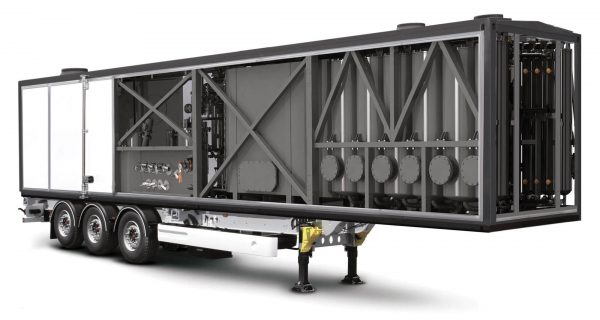 CMM-12R Oil Regeneration ...
CMM-12R Oil Regeneration ...